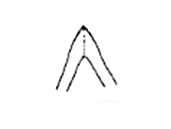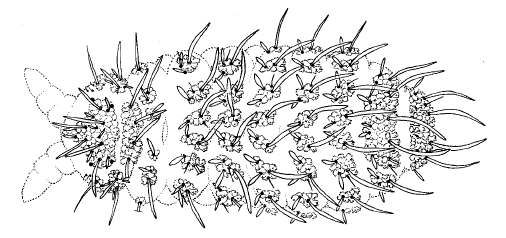| Checklist of the Collembola: Key to the species of Monobella |
This key is still under construction. Note that missing figures will be provided as soon as possible. Currently, the key is in the feasibility study phase to find out how to integrate in the checklist in a modular way a key that has been generated with DELTA.
Anne Bedos,
Laboratoire d'Ecologie Terrestre, UMR 5552 du CNRS, UPS, Toulouse Cedex 4, 31062, France
Louis Deharveng,
Laboratoire d'Ecologie Terrestre, UMR 5552 du CNRS, UPS, Toulouse Cedex 4, 31062, France
Frans Janssens,
Department of Biology, University of Antwerp, Antwerp, B-2020, Belgium
1(0). Labrum distally ogival (fig.1).............................. 2 Labrum non-ogival........................................... 4 |
|
 |
|
2(1). Third abdominal segment with the dorso-internal tubercles fused............................................ cassagnaui Third abdominal segment with the dorso-internal tubercles separate.................................................. 3 |
|
3(2). Third abdominal segment to second thoracic segment with the dorso-internal and dorso-external tubercles fused.. rostrata Third abdominal segment to second thoracic segment with the dorso-internal and dorso-external tubercles separate (fig.2)........................................... rousseti |
|
 |
|
4(1). First antennal segment with 7 chaetae....................... 5 First antennal segment with 8-9 chaetae.................... 12 |
|
5(4). Second thoracic segment with the dorso-internal and dorso-external tubercles fused............................ 6 Second thoracic segment with the dorso-internal and dorso-external tubercles separate......................... 7 |
|
6(5). Head with chaetae c always short macrochaetae, at the level of the chaetae b (fig.3a); short macrochaetae broad...... minor Head with chaetae c microchaetae or short macrochaetae, ahead the chaetae b (fig.3b); short macrochaetae thin..... grassei |
|
 |
|
7(5). Fourth abdominal segment with the dorso-external tubercles fused to the dorso-internal tubercles..................... 8 Fourth abdominal segment with the dorso-external tubercles not fused to the dorso-internal tubercles..................... 9 |
|
8(7). Head with chaetae di2, de2, dl6 absent or minute microchaetae. ..................................................... calva Head with chaetae di2, de2, dl6 short macrochaetae............ .............................................. prodistincta |
|
9(7). Fifth abdominal segment with 6 chaetae, 5 + s, on the tubercle de + dl + l; third abdominal segment with 4 chaetae ve...... ................................................. pyrenaica Fifth abdominal segment with 7-8 chaetae, 6-7 + s on the tubercle de + dl + l, rarely 5 + s on one side; third abdominal segment with 5-7 chaetae ve.................... 10 |
|
10(9). Fourth abdominal segment with 6-7 chaetae on the tubercle l... ........................................................ 11 Fourth abdominal segment with 8 chaetae on the tubercle l..... ..................................................... gersi |
|
11(10). Body size less than 1.5 mm; second abdominal segment with 5 chaetae ve; short macrochaetae enlarged (fig.4b)... edaphica Body size more than 1.9 mm; second abdominal segment with 6-7 chaetae ve; short macrochaetae thin (fig.4a)............ jau |
|
 |
|
12(4). Fourth abdominal segment with the dorso-external tubercles fused to the dorso-internal tubercles.................... 13 Fourth abdominal segment with the dorso-external tubercles not fused to the dorso-internal tubercles................. dubia |
|
13(12). Second thoracic segment with the dorso-internal and dorso-external tubercles fused.................. banyulensis Second thoracic segment with the dorso-internal and dorso-external tubercles separate................. distincta |
|
banyulensis
First antennal segment with 8–9 chaetae. Fourth
abdominal segment with the dorso-external tubercles fused to the
dorso-internal tubercles. Labrum non-ogival. Second thoracic segment with the
dorso-internal and dorso-external tubercles fused.
calva
First antennal segment with 7 chaetae. Fourth abdominal
segment with the dorso-external tubercles fused to the dorso-internal
tubercles. Head with chaetae di2, de2, dl6 absent or minute microchaetae.
Labrum non-ogival. Second thoracic segment with the dorso-internal and
dorso-external tubercles separate.
cassagnaui
Labrum distally ogival (fig.1). Third abdominal
segment with the dorso-internal tubercles fused.
distincta
First antennal segment with 8–9 chaetae. Fourth
abdominal segment with the dorso-external tubercles fused to the
dorso-internal tubercles. Labrum non-ogival. Second thoracic segment with the
dorso-internal and dorso-external tubercles separate.
dubia
First antennal segment with 8–9 chaetae. Fourth
abdominal segment with the dorso-external tubercles not fused to the
dorso-internal tubercles. Labrum non-ogival.
edaphica
Body size less than 1.5 mm. Fifth abdominal segment
with 7–8 chaetae, 6–7 + s on the tubercle de + dl + l, rarely 5 + s
on one side. First antennal segment with 7 chaetae. Fourth abdominal segment
with 6–7 chaetae on the tubercle l. Fourth abdominal segment with the
dorso-external tubercles not fused to the dorso-internal tubercles. Labrum
non-ogival. Second abdominal segment with 5 chaetae ve. Second thoracic
segment with the dorso-internal and dorso-external tubercles separate. Short
macrochaetae enlarged (fig.4b). Third abdominal segment with 5–7 chaetae
ve.
gersi
Fifth abdominal segment with 7–8 chaetae, 6–7 +
s on the tubercle de + dl + l, rarely 5 + s on one side. First antennal
segment with 7 chaetae. Fourth abdominal segment with 8 chaetae on the
tubercle l. Fourth abdominal segment with the dorso-external tubercles not
fused to the dorso-internal tubercles. Labrum non-ogival. Second thoracic
segment with the dorso-internal and dorso-external tubercles separate. Third
abdominal segment with 5–7 chaetae ve.
grassei
First antennal segment with 7 chaetae. Head with chaetae
c microchaetae or short macrochaetae, ahead the chaetae b (fig.3b). Labrum
non-ogival. Second thoracic segment with the dorso-internal and dorso-external
tubercles fused. Short macrochaetae thin.
jau
Body size more than 1.9 mm. Fifth abdominal segment with
7–8 chaetae, 6–7 + s on the tubercle de + dl + l, rarely 5 + s on
one side. First antennal segment with 7 chaetae. Fourth abdominal segment with
6–7 chaetae on the tubercle l. Fourth abdominal segment with the
dorso-external tubercles not fused to the dorso-internal tubercles. Labrum
non-ogival. Second abdominal segment with 6–7 chaetae ve. Second thoracic
segment with the dorso-internal and dorso-external tubercles separate. Short
macrochaetae thin (fig.4a). Third abdominal segment with 5–7 chaetae ve.
minor
First antennal segment with 7 chaetae. Head with chaetae c
always short macrochaetae, at the level of the chaetae b (fig.3a). Labrum
non-ogival. Second thoracic segment with the dorso-internal and dorso-external
tubercles fused. Short macrochaetae broad.
prodistincta
First antennal segment with 7 chaetae. Fourth
abdominal segment with the dorso-external tubercles fused to the
dorso-internal tubercles. Head with chaetae di2, de2, dl6 short macrochaetae.
Labrum non-ogival. Second thoracic segment with the dorso-internal and
dorso-external tubercles separate.
pyrenaica
Fifth abdominal segment with 6 chaetae, 5 + s, on the
tubercle de + dl + l. First antennal segment with 7 chaetae. Fourth abdominal
segment with the dorso-external tubercles not fused to the dorso-internal
tubercles. Labrum non-ogival. Second thoracic segment with the dorso-internal
and dorso-external tubercles separate. Third abdominal segment with 4 chaetae
ve.
rostrata
Labrum distally ogival (fig.1). Third abdominal segment
to second thoracic segment with the dorso-internal and dorso-external
tubercles fused. Third abdominal segment with the dorso-internal tubercles
separate.
rousseti
Labrum distally ogival (fig.1). Third abdominal segment
to second thoracic segment with the dorso-internal and dorso-external
tubercles separate (fig.2). Third abdominal segment with the dorso-internal
tubercles separate.